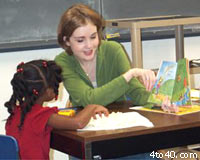 Whenever children feel threatened, instead of making them come to you, meet them at their safe place, and together from there move to new places. Remember, a path is usually neutral territory. Walking to a new place together provides a gentle way of being together, allowing to grow accustomed to each other.
Whenever children feel threatened, instead of making them come to you, meet them at their safe place, and together from there move to new places. Remember, a path is usually neutral territory. Walking to a new place together provides a gentle way of being together, allowing to grow accustomed to each other.
When I was about to begin tutoring a new child, especially a younger one, I often felt it was important to go to the child’s classroom and walk together to the tutoring room, instead of simply having the child come to me. At least for the first couple of sessions, I did this for almost every tutoring client; with very young ones, I did it almost all the time. For the first few sessions, I might even walk them back to their classrooms afterward.
Usually for this walk I would bring some object I thought they might be interested into help them feel comfortable, especially at the beginning of our relationship.
The first time I went to wait for eight-year-old Sandy, she was so scared her usually pale skin was red with anxiety. As we walked together to the tutoring room, I told her my name and asked her name. Then I asked her where she lived, and she was so anxious she could not remember. I quickly went on to another topic so as not to let her stay caught in her embarrassment.
“I have three children,” I said. “Do you have any brothers or sisters?”
Haltingly, she said, “Yes.” Then I realized the very act of talking was difficult for her in her anxiety about beginning tutoring work.
 So I opened my purse and took out a very large prism. I handed it to her, saying it belonged to one of my daughters who was her age. I suggested one of the fun things to do with it (as my children discovered) was to look through it as you walked. So she held the prism in front of her eyes and looked at the changing view as we walked.
So I opened my purse and took out a very large prism. I handed it to her, saying it belonged to one of my daughters who was her age. I suggested one of the fun things to do with it (as my children discovered) was to look through it as you walked. So she held the prism in front of her eyes and looked at the changing view as we walked.
She rewarded me with a smiling comment, “That’s neat!”
By that time we were at the tutoring room and it was easier to step into the new place. I suggested she could also look at the window view through the prism. She took time doing that to become comfortable in the room with me. I had a mandate to teach Sandy reading and spelling, but my agenda that day was getting comfortable with each other, not teaching. And in every way I could I reached out and made our time together as nonthreatening as possible.
While her classroom was her safe place, the tutoring room was a new place. The path from the classroom to my room had been neutral territory. I began relationship building in the neutral territory. Not only did I show interest in her, but I wanted to bring physical objects, like the prism, into her life that would interest her. For children, concrete things symbolized my wish to bring new learning experiences into their lives. The prism was not just some toy, it symbolized seeing and learning in new ways with different materials. It summarized the kinds of learning that would go on in our sessions.
It’s difficult for many adults to remember how threatening almost every new situation is for a child, including going to a new school, a hospital, a doctor’s office, summer camp, etc. Even going to a birthday party at a home the child has never been to before can be anxiety producing.
 When, as a parent or teacher, you are taking a child to any new place, which might provoke anxiety, instead of rushing the child and hurrying them out the door, make the going as nonthreatening as possible. First of all, give the child time to get ready at his or her own pace. Second, allow time for discussing the experience and describe to the child what the experience will be like in as nonthreatening a way as possible. Third, anticipate some of the questions the child might have but is not brave enough to ask you. You can answer these unasked questions by beginning, “You might be wondering about…” Fourth, reassure the child you will physically accompany the child to and from the place.
When, as a parent or teacher, you are taking a child to any new place, which might provoke anxiety, instead of rushing the child and hurrying them out the door, make the going as nonthreatening as possible. First of all, give the child time to get ready at his or her own pace. Second, allow time for discussing the experience and describe to the child what the experience will be like in as nonthreatening a way as possible. Third, anticipate some of the questions the child might have but is not brave enough to ask you. You can answer these unasked questions by beginning, “You might be wondering about…” Fourth, reassure the child you will physically accompany the child to and from the place.
In all of this let your voice be an instrument of comfort as well as of information. The comforting sound of your voice will have its effect, even if much of your information does not make it through the barrier of anxiety.
It is very helpful to allow the child enough time to prepare so as not to feel hurried. The ideal is to have the child feel he or she is being invited to go willingly, that is, supported and encouraged to go, but not forced.
In giving the child enough time, much self-esteem building goes on. The child feels somehow he or she is considered an important enough person to be waited for, that his or her own pace of getting ready is respected. Your wanting the relationship and the situation to be a safe one says the child is valuable to you. Your willingness to be physically present says, “Your security is important to me.”
In the process you, the adult, are learning a certain amount of patience and trust in yourself. And the sense of cooperation that’s present speaks of a mutual esteem.
Self-Esteem Principle: Self-esteem grows best in children when they have plenty of time in a safe or neutral place to check things out before they finally trust themselves to a new or possibly threatening situation.
 Kids Portal For Parents India Kids Network
Kids Portal For Parents India Kids Network






